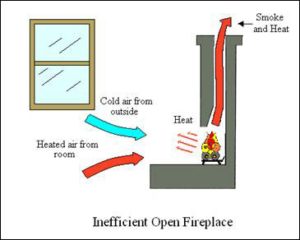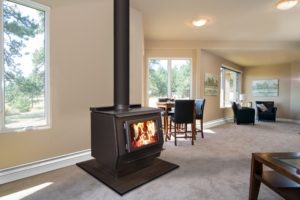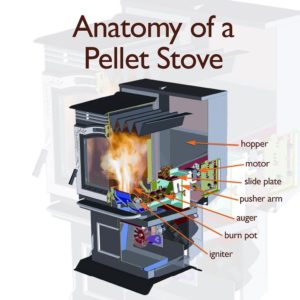Do Fireplaces Save Money?
Every time I perform a home inspection and look up the chimney, I get the same questions. Can the fireplace heat the home? Or do fireplaces save money? Sometimes both, and more.
Wood is often regarded as the first fuel source. It has been used for thousands of years for cooking, heating, and energy production. Despite its decline in use, more than 2 billion worldwide still rely on wood for heating and cooking. In fact, 20 percent of US homes use wood for heat. And 4 percent of US homes use wood as their primary energy source for heat.
Wood itself is one of the cheapest energy sources in the US. In fact, depending on the costs of wood and natural gas in your area, it is likely that wood is the cheapest energy source in your area. That doesn’t necessarily mean that a fireplace can heat your home or save you money though.
Most experts, including the U.S. Department of energy, agree that the efficiency of a wood fireplace is only about 10 percent. That means that all of the heat created in the fireplace, 10 percent is heat output, and 90 percent is heat loss.
In other words, 90 percent of the heat created is lost out the chimney. If you spend $400 on a cord of wood, $360 of it zigzags through the fireplace damper, into the smoke chamber, up the chimney and out into the air. Obviously a fireplace is not the most efficient way to heat your home. And it doesn’t matter how cheap wood is if 90 percent of your dollars are burned up and floated out the chimney.
Efficiency isn’t everything though. Electric fireplaces, and electric fireplace inserts are nearly 100 percent efficient. Almost all of the heat created by these fireplaces is directed into the living space. However, the cost of electricity is high, and electric fireplace heat is the most expensive type of heat.
Gas Is Not Much Better
Direct vent natural gas fireplaces are much better than an open wood fireplace, but aren’t great either. These fireplaces are about 50-60 percent efficient. Although you could get a ventless model that is 90 percent efficient or higher, these are generally not safe and counter productive. Since there is no chimney, or vent, some of the manufacturers recommend using them with an open window in the immediate area of the fireplace. I don’t know about you, but I don’t want to an open a window in the winter when I am using my fireplace. I also don’t want carbon monoxide poisoning.
All of these types of fireplaces are great for decorative purposes. On a cold winter day you can cozy up in front of the fire, with your wool socks, favorite pajamas, and steaming mug of coffee. Don’t forget a photo for the gram. None of these are good for reducing your heating bill, and a traditional wood fireplace isn’t good for any amount of heat or lowering your bill.
Fireplace Draft
It’s not just that fireplaces hurl most of the heat created up the chimney, they also steal heated air from your home that was generated by your furnace. Fires need oxygen to to continue to burn. Naturally, an open fireplace draws in the oxygen from the room to keep the fire alive.
The draft created by the chimney also pulls air from the room. Fireplaces and chimneys rely on natural draft to expel heat, smoke, and combustion products. You have probably heard that hot air rises. As the fire heats the air around it, this air is lifted up the chimney. In a nutshell, that is draft. This draft also pulls air from the adjacent space or room. You may feel like the room is getting hotter because of the radiant heat of the fire, but it is actually getting colder.
If your fireplace has glass doors, and combustion air vent that draws the needed oxygen from outside, instead of inside, then you can increase the efficiency a little, but it is still not worth it. The crackling fire might be good for your soul, but not your wallet
Use a Wood Stove Instead
Wood stove technology has come a long way. They are a great option for heating your home and saving money. There are many options to choose from. They range from 70%-90% efficiency. They come in small sizes to heat a small room, or larger sizes to heat the whole house.
Most even come with large glass windows in the door for the added benefit of the visual ambiance of a roaring fire in the family room.
The biggest drawback to a wood stove is storing and loading the wood. The burn time for a modern wood stove can range from 6-12 hours. If you are considering getting a wood stove as a primary or supplemental heat source, keep in mind you’ll need to load it 2-4 times a day to keep the fire going.
They’re also pretty dirty and required regular cleaning and sweeping from a chimney sweep.
If you already have an old fireplace, you may be be able to have a wood stove insert installed in it depending on the size of the fireplace opening. If not, there are also free standing models available.
Pellet Stoves are Great Too
Pellet stoves use little man made wood pellets of compacted wood dust. Some pellets are made of corn, cherry pits, or other biofuels. Although it cost more to heat a space with pellets over traditional wood, pellet stoves shine where wood stoves don’t. Pellet stoves are easy to load and start. A circuit board monitors the temperature and automatically adds more pellets as needed. Obviously this automation and convenience requires electricity which some see as a drawback. However, the cost to run a pellet stove is 10 dollars a month, or less.
They’re much cleaner than wood stoves,and produce less smoke, but will still need cleaning and sweeping from a chimney sweep on an annual basis.
Just like wood stoves they come in varying efficiencies and sizes. Many even operate by remote control and even bluetooth!
Get the Most Out of Your Fireplace or Woodstove
If you are dead set on using your open fireplace, or you’re ready to invest in a wood stove, there are some simple steps to get the maximum efficiency out if it.
- Use Dry Wood Only. When heat from the fire is wasted evaporating the moisture in wet wood, it’s not being used to blanket your body with warm air. It takes 3-12 months to season wood, also known as dry wood.
- Test the moisture in your wood. Firewood should be below 20 percent moisture. A moisture meter is a great way to make sure you are using seasoned wood, and getting more efficiency out of your fireplace or wood stove.
- Don’t use cold firewood. If you bring in your wood long before you’re ready to use it, it has time to warm up to room temperature. Cold wood takes more energy to heat before it burns.
- Use hardwood. Softwoods such as pine do not burn as long, or as hot as hardwoods such as oak or maple. Hardwoods are denser giving you longer, hotter burns.
- Use the Top-Down burning method.
Will You Actually Save Money Though?
Although heating with wood will almost certainly lower your heating costs, there are additional costs to consider when considering money saving upgrades. You will need to consider the total cost of your upgrade including installation, and regular maintenance. Some upgrades value to the home. Talk to a Realtor about how much a wood stove or pellet stove can increase your homes value.
Subtract the value it adds to your home from the total cost of the upgrade. This is your total net cost.
Then estimate your annual savings minus the cost of annual maintenance. This is your total net savings.
Factor in how long will you think you will live in the house. Multiply your total net savings by how many years you think you’ll live in the home. If this number is greater than your total net cost, then you are saving money.
Some things you can’t put a price on though such as knowing you are helping the environment by using less fossil fuels and renewable energy. Some homeowners are attracted to the idea of having a heating system that is not dependent on the “grid”. Sometimes, homeowners are willing to break even, or even lose money on personal principles.
The Bottom Line
Conventional wood fireplaces don’t give you much heat, or save you money. In most cases they actually take heat away from your home and increase your energy bills. Although a warm fire in the winter months can provide a warm glowing ambiance, a fireplace is not suited for home heating. Vented gas fireplaces are better, but not great, and unvented gas fireplaces are just silly.
If you want to produce enough heat for larger rooms, or an entire room AND save money, get a wood stove, or pellet stove.
Wood Stoves are great if you don’t mind storing and loading wood, and monitoring the fire.
If you’re willing to sacrifice the ambiance and some of the savings for ease of use, get a pellet stove.
Related Read: Can You Save Money By Closing Unused Vents?






